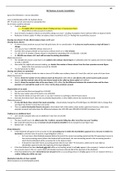Summary
Summary Accelerated LPC - Business Law and Practice (BLP) Business Accounts Cheat Sheet
- Module
- Business Law and Practice
These are for the Accelerated LPC Business Accounts part of BLP. Overall score received for BLP was 87% using these notes. **Available as part of a bundle with overall BLP Consolidation notes.
[Show more]



